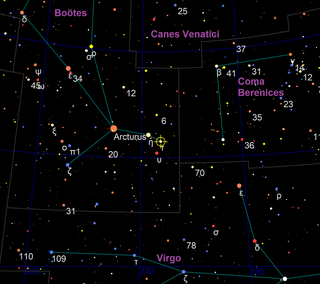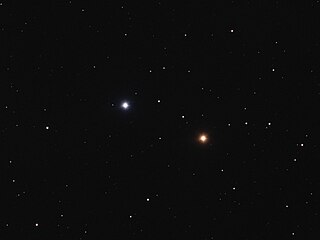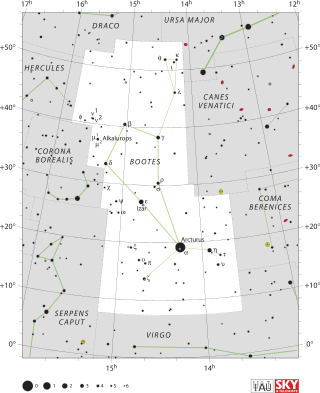
Tau Boötis, Latinised from τ Boötis, is an F-type main-sequence star approximately 51 light-years away in the constellation of Boötes. It is a binary star system, with the secondary star being a red dwarf. In 1999, an extrasolar planet was detected orbiting the primary star.

Sigma Draconis is a single star in the northern constellation of Draco. It has the proper name Alsafi, while Sigma Draconis, which is latinised from σ Draconis and abbreviated Sig Dra or σ Dra, is the Bayer designation. It has an apparent visual magnitude of 4.7, which is bright enough to be faintly visible to the naked eye. Based on parallax measurements, this star is located at a distance of 18.8 light years from the Sun. It is receding from the Sun with a radial velocity of 26.6 km/s.
Xi Boötis, Latinised from ξ Boötis, is a binary star system located at a distance of 22 light-years away from Earth. It is the nearest visible star in the constellation Boötes. The brighter, primary component of the pair has a visual magnitude of 4.70, making it visible to the naked eye.
Sigma Serpentis, Latinized from σ Serpentis, is a star in the equatorial constellation Serpens. It is faintly visible to the naked eye with an apparent visual magnitude of +4.82. Based upon an annual parallax shift of 36.67 mas as seen from Earth, it is located 89 light years from the Sun. The star is moving closer to the Sun with a radial velocity of −49 km/s.

Rho Virginis is the Bayer designation for a star in the constellation Virgo. It has an apparent visual magnitude of +4.9, making it a challenge to view with the naked eye from an urban area. The distance to this star has been measured directly using the parallax method, which places it 118.3 light-years away with a margin of error of about a light year.

Sigma Andromedae, Latinized from σ Andromedae, is the Bayer designation for a single star in the northern constellation of Andromeda. It has an apparent visual magnitude of +4.5, which is bright enough to be seen with the naked eye from most locations. Parallax measurements made during the Gaia mission place it at a distance of about 140 light-years. The magnitude of the star is diminished by 0.08 from extinction caused by intervening gas and dust. It is drifting closer to the Sun with a radial velocity of –8 km/s.

Nu1 Boötis (ν1 Boötis) is an orange-hued star in the northern constellation of Boötes. It has an apparent visual magnitude of +5.02, which indicates the star is faintly visible to the naked eye. Based upon an annual parallax shift of 3.35 mas as seen from Earth, it is located roughly 970 light years distant from the Sun. At that distance, the visual magnitude of the star is diminished by an extinction of 0.13 due to interstellar dust.

Upsilon Boötis is a single, orange-hued star in the northern constellation of Boötes. It is a fourth magnitude star that is visible to the naked eye. Based upon an annual parallax shift of 12.38 mas as seen from the Earth, it is located about 263 light years from the Sun. The star is moving closer to the Sun with a radial velocity of −6 km/s.
Chi Boötis, Latinised as χ Boötis, is a single, white-hued star in the northern constellation Boötes, near the eastern constellation border with Corona Borealis. It is faintly visible to the naked eye with an apparent visual magnitude of +5.3. Based upon an annual parallax shift of 13.0 mas as seen from the Earth, it is located about 251 light-years from the Sun. The star is moving closer to the Sun with a radial velocity of −16 km/s.
22 Boötis is a single star in the northern constellation of Boötes, located 319 light years away from the Sun. It has the Bayer designation f Boötis; 22 Boötis is the Flamsteed designation. This object is visible to the naked eye as a dim, white-hued star with an apparent visual magnitude of 5.40. It is moving closer to the Earth with a heliocentric radial velocity of −27 km/s.

44 Boötis or i Boötis is a triple star system in the constellation Boötes. It is approximately 41.6 light years from Earth.

Sigma Orionis or Sigma Ori is a multiple star system in the constellation Orion, consisting of the brightest members of a young open cluster. It is found at the eastern end of the belt, south west of Alnitak and west of the Horsehead Nebula which it partially illuminates. The combined brightness of the component stars is magnitude 3.80.
Lambda Geminorum, Latinized from λ Geminorum, is a candidate multiple star system in the constellation Gemini. It is visible to the naked eye at night with a combined apparent visual magnitude of 3.57. The distance to this system is 101 light years based on parallax, and it is drifting closer with a radial velocity of –7.4 km/s. It is a member of what is suspected to be a trailing tidal tail of the Hyades Stream.

Iota Piscium is a single, F-type main-sequence star located 45 light years from Earth, in the constellation Pisces. Its spectral type is F7V, which means that it is somewhat larger and brighter than the Sun, but still within the range considered to have the potential for Earth-like planets. It has a surface temperature of about 6,000 to 7,500 K. Iota Piscium is suspected to be a variable star, and was once thought to have one or two stellar companions, but both are line-of-sight coincidences. It displays a far-infrared excess at a wavelength of 70μm, suggesting it is being orbited by a cold debris disk.
HD 5789 and HD 5788 is a pair of stars comprising a binary star system in the northern constellation of Andromeda. Located approximately 151 parsecs (490 ly) away, the primary is a hot, massive blue star with an apparent magnitude of 6.06 while the secondary is slightly smaller and cooler, with an apparent magnitude of 6.76. Both stars are main-sequence stars, meaning that they are currently fusing hydrogen into helium in their cores. As of 2016, the pair had an angular separation of 7.90″ along a position angle of 195°. While both have a similar proper motion and parallax, there's still no proof that the pair is gravitationally bound.
HD 225218 is a quadruple star system in the northern constellation of Andromeda. The primary component, HD 225218 A, is a giant star with a stellar classification of B9III, an apparent magnitude of 6.16, and is a candidate Lambda Boötis star. It has a fainter, magnitude 9.65 companion, HD 225218 B, at an angular separation of 5.2″ along a position angle of 171°. The primary itself has been identified as a binary star system through interferometry, with the two components separated by 0.165″. The pair, HD 225218 Aa and Ab, orbit each other with a period of about 70 years and an eccentricity of 0.515. Component B is likewise a spectroscopic binary.
HD 130917 is a single star in the northern constellation of Boötes. It is an A-type main sequence star with a stellar classification of A4V. At an apparent magnitude of 5.80, it is visible to the naked eye.
16 Camelopardalis is a single star in the northern circumpolar constellation Camelopardalis, located 348 light years away from the Sun as determined from parallax measurements. It is visible to the naked eye as a faint, white-hued star with an apparent visual magnitude of 5.28. This object is moving further from the Earth with a heliocentric radial velocity of around 12 km/s.
Sigma Ceti is the Bayer designation for a star in the equatorial constellation of Cetus. With an apparent visual magnitude of 4.78, it can be seen with the naked eye on a dark night. Based upon an annual parallax shift of 37.46 mas, it lies at an estimated distance of 87.1 light years from the Sun. It is a probable astrometric binary star system.
σ Pegasi, Latinised as Sigma Pegasi, is a binary star system in the northern constellation of Pegasus. With a combined apparent visual magnitude of 5.16, it is faintly visible to the naked eye. Based upon an annual parallax shift of 36.66 mas as seen from Earth, the system is located 89 light years distant from the Sun. It has a relatively high proper motion, advancing across the celestial sphere at the rate of 0.524 arcseconds per year.









